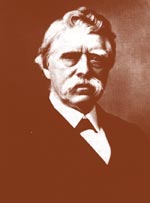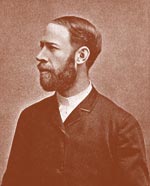Who discovered radio?
How do we know that electricity, magnetism and light are all
part of one electromagnetic spectrum, and can be considered as travelling in
waves?
It is mainly due to the work of scientists in the 19th century, whose
discoveries became the basis for the invention of practical radio sets.
The fruitful year of 1831
In 1802, Gian Domenico Romagnosi was the first to publish the suggestion that
electricity and magnetism are related. In 1820, Hans Christian ěrsted found that
an electric current produces a magnetic field as it flows through a wire. In the
1830s, American scientist Joseph Henry wound wire around iron cores to make
electromagnets and experimented with using electricity to induce magnetism
remotely. He was working at about the same time as Michael
Faraday (1791–1867), the British scientist who described the phenomenon of
electromagnetic induction in 1831.

Did David Edward Hughes use radio to receive the world’s first
mobile phone call? |
|
Induction occurs when an electric field is produced by a
changing magnetic field, or vice versa. Faraday also established that magnetism
can affect rays of light, demonstrating the relationship between the two
phenomena. Importantly, he suggested that lines of electromagnetic force extend
from charged bodies into their surroundings — an essential concept on the way to
radio. In the year that Faraday formulated his law of induction, a Scottish
physicist was born who consolidated it into a set of mathematical laws on
electromagnetism: James Clerk Maxwell (1831–1879).
Albert Einstein described Maxwell’s work as "the most
profound and the most fruitful that physics has experienced since the time of
Newton". In 1864, he incorporated Faraday’s law into a comprehensive model known
as Maxwell’s Equations. These predicted that electric and magnetic fields travel
through space in waves at the speed of light. Maxwell concluded that light is
indeed an electromagnetic wave, and said that other types of phenomena at
different wavelengths should also exist. In other words, he predicted the
existence of radio.
But who first observed radio waves in reality? A number of
investigators noticed "electricity at a distance" including Thomas Alva Edison,
who in 1875 said he had encountered "aetheric force" while working on
telegraphy. But to answer the question posed in the previous Pioneers’ Page,
it was another scientist born in Britain in 1831, David Edward Hughes, who was
the first person to definitely record sending and receiving a radio signal.
Microphone and "mobile phone"
Hughes (1831–1900) was best known for his inventions in
telegraphy (see Pioneers’ Page for July/August 2007). In 1876 the telephone was invented
and, like others, Hughes began experiments to improve its transmission of sound.
His system comprised a tube containing two carbon rods in loose contact,
included in an electrical circuit with a battery. When the tube was subjected to
sound vibrations, the electrical resistance varied to match the sound waves’
form. In 1878, Hughes announced his invention, which he called a "microphone".
Continuing his research, Hughes discovered that the
carbon-filled tubes were also sensitive to "sudden electric impulses". To test
at what distance this effect could act, Hughes set up a source of regular
electric sparks in his house and then walked out into the street carrying a tube
in circuit with a battery and a telephone. He found that, as the sparks were
generated, he could hear corresponding clicks in the telephone from up to
500 yards (457 metres) away. It was not a modulated signal — let alone words —
that he heard; however, in a sense, in 1878 Hughes had received the world’s
first mobile phone call.
Hughes suggested that this wireless transmission of signals
in the super low frequency range was accomplished through "electric waves" that
could travel through buildings and the air. He demonstrated his results to the
Royal Society in 1880, but they were considered to be due to induction rather
than electricity acting at a distance. He finally received credit for his work
many years later, after a sound experimental framework for radio had been laid
by the German scientist Heinrich Rudolf Hertz (1857–1894).
Action at a distance
|
|

Heinrich Rudolf Hertz established the experimental framework for
radio |
Hertz validated Maxwell’s theory through experimentally
proving the existence of electromagnetic waves. He confirmed that light is a
form of radiation and, using a spark-gap transmitter, in 1888 produced ultra
high frequency (UHF) radio waves at around 100 MHz in the shortwave band. He
also found that radio waves could be transmitted through, or stopped by, various
materials and could be focused by parabolic reflectors. "Action at a distance is
for the first time proved," said Hertz in the 1893 English edition of his work
(published in German in 1891). "Electric forces can disentangle themselves from
material bodies, and can continue to subsist as conditions or changes in the
state of space."
We now measure radio frequencies in a unit called "Hertz". But despite the
triumph of his research, the scientist did not envisage any useful applications
of his experiments. He died at the early age of 37 at about the same time that
such figures as Tesla, Popov and Marconi began work that led to practical radio
systems — more than a decade after Hughes’s original observations.
| |
Question for next time
Who was "the man who brought silicon to
Silicon Valley"? |
|
|


